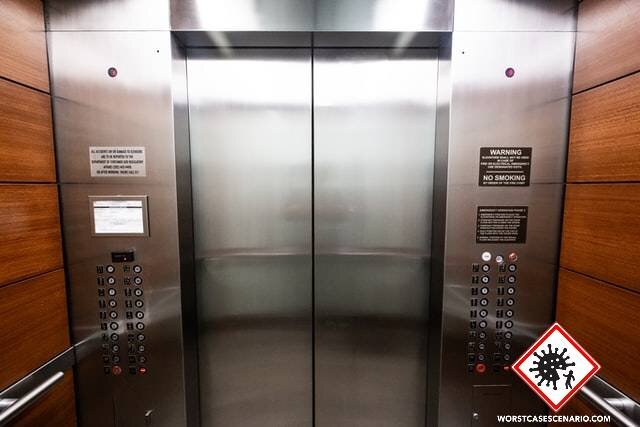How to Survive When Stuck in an Elevator
Photo by Derrick Treadwell on Unsplash.
Congratulations and thanks to Olivia for sharing her fear and suggesting this Worst-Case Scenario! Before we get to the answer, we asked Olivia a few questions about her fear.
WCS: Why is this a fear of yours?
Olivia: Elevators have always scared me. Something about being enclosed in a metal, mostly windowless box suspended in a shaft with cables that could slice you in half. It’s not appealing. Getting stuck in an elevator for potentially hours is horrifying, but having it fall would be the absolute worst.
I still use elevators, even though they make me uncomfortable. Sometimes you just have to push through fear. I do refuse to get on overcrowded elevators, though.
WCS: Have you ever had a frightening incident in an elevator?
Olivia: I have gotten stuck in an elevator for a little while. I used to work in a building that was extremely old (it was originally a TB hospital) and the elevator was notorious for getting stuck between floors. Some people said it was haunted. I don’t believe in that so much, but it still was creepy. One of my friends had to push the doors open and then pull herself onto the next floor.
WCS: What do you think the right answer is?
Olivia: I feel like I’ve heard you have to jump right before an elevator hits the ground. I feel like that would be very hard to time. Maybe trying to hold onto a rail and keep yourself suspended? Or maybe even lying in the center of the floor as limply as possible. I guess the best case scenario would be falling from the first floor.
1. Stay calm and do not panic.
2. Use the call button or emergency button to call for help, and wait.
If you have cell reception, call 911 for assistance.
3. Do not attempt to open the doors or escape through the shaft.
Unless there is other danger in the building, you are better off remaining calm and waiting for help. Elevators have numerous safety features. There have been very few recorded incidents involving death from plummeting elevators. In general, it is highly unlikely for a cable (also called traction) elevator to fall all the way to the bottom of the shaft. Moreover, the compressed air column in the elevator hoistway and the car buffers at the bottom of the hoistway may keep the forces of the impact survivable.
4. Flatten your body against the car floor if the car does begin to fall.
While there is disagreement among the experts, most recommend this method. This should distribute the force of impact, rather than concentrate it on one area of your body. (Standing may be difficult anyway.) Lie in the center of the car.
5. Cover your face and head to protect them from ceiling parts that may break loose.
Jumping just before the elevator hits the bottom is not a viable alternative. The chances that you will time your jump exactly right are infinitesimally small. Besides, the elevator will not remain completely intact when it hits—it will likely collapse around you.
Be Aware
Hydraulic elevators are more likely than cable elevators to fall. These elevators are pushed from the bottom by a giant piston, similar to car jacks at service stations. Because the jack is subject to ground corrosion, it can rot, which could eventually cause the car to fall. The height of hydraulic elevators is limited to about 70 feet, so a free fall would probably result in injury—but not death.

